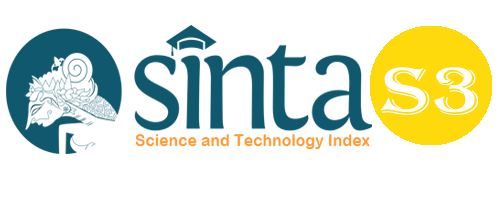The Effect of Cash Flow, ROA, Rupiah Exchange Rate, Company Size, NPM, DER on Stock Returns in Textile and Garment Sub-Sector Manufacturing Companies Listed on the IDX for the 2018-2020 Period
Abstract
This study aims to test whether cash flow, return on assets, rupiah exchange rate, company size, net profit margin, and debt equity ratio have an effect on the company's stock return. This research was conducted on textile and garment sub-sector manufacturing companies for the period 2018 – 2020 with a research population of 21 (twenty one) companies listed on the Indonesia Stock Exchange. The sampling technique used in this research is purposive sampling and then obtained a sample of 10 (ten) companies. The data used are the financial reports of each sample company published on the www.idx.co.id website. The research method used is associative analysis method and multiple linear regression analysis method. The dependent variable is cash flow, return on assets, rupiah exchange rate, company size, net profit margin, and debt equity of ratio. The results showed that partially cash flow and return on assets had a significant effect on stock returns, while the rupiah exchange rate, company size, net profit margin, and debt equity of ratio had no significant effect on stock returns.
Keywords
Full Text:
PDFReferences
Abdallah, Z. (2018). Pengaruh Nilai Tukar Rupiah Terhadap Return Saham Dengan Return On Asset Sebagai Variabel Intervening Pada Perusahaan Rokok. Akuisisi I Jurnal Akuntansi, 14(1).
Daljono, B. N. (2013). Pengaruh Kinerja Keuangan Terhadap Return Saham (Studi Empiris Perusahaan Automotive and Component yang Listing di Bursa Efek Indonesia Periode 2005-2011). Diponegoro Journal of accounting, 2(1), 1-11.
Ghozali, I. (2016) Aplikasi Analisis Multivariete Dengan Program IBM SPSS 23. Edisi 8. Semarang: Badan Penerbit Universitas Diponegoro.
Imam Ghozali. (2011). Aplikasi Analisis Multivariate dengan Program IMB SPSS 19. Semarang. Badan Penerbit Undip.
Magdalena, S., Suhatman, R. (2020). The Effect of Government Expenditures, Domestic Invesment, Foreign Invesment to the Economic Growth of Primary Sector in Central Kalimantan. Budapest International Research and Critics Institute-Journal (BIRCI-Journal). Volume 3, No 3, Page: 1692-1703.
Prasetyo, A., & Adi, S. W. (2018). Pengaruh Kinerja Keuangan dan Ukuran Perusahaan Terhadap Return Saham (Studi Kasus Pada Perusahaan Sektor Property, Real Estate dan Konstruksi Bangunan yang Terdaftar di BEI Tahun 2013-2016) (Doctoral dissertation, Universitas Muhammadiyah Surakarta).
Putra, F. E. P. E., & Kindangen, P. (2016). Pengaruh return on asset (ROA), Net profit margin (NPM), dan earning per share (EPS) terhadap return saham perusahaan makanan dan minuman yang terdaftar di Bursa Efek Indonesia (Periode 2010-2014). Jurnal EMBA: Jurnal Riset Ekonomi, Manajemen, Bisnis dan Akuntansi, 4(3).
Sadita, G., Kristanto, A. B., & Rita, M. R. (2019). Relevansi Nilai Inkremental Arus Kas dan Laba Terhadap Return Saham: Kajian dalam Kondisi Moderat dan Ekstrem. Jurnal Akuntansi Keuangan dan Bisnis, 12(2), 29-38.
Shah, M. M., et al. (2020). The Development Impact of PT. Medco E & P Malaka on Economic Aspects in East Aceh Regency. Budapest International Research and Critics Institute-Journal (BIRCI-Journal). Volume 3, No 1, Page: 276-286
Sugiyono. (2012). Teknik pengambilan sampel purposive adalah teknik penentuan sampel dengan pertimbangan tertentu. Dalam penelitian ini peneliti akan menetapkan beberapa kriteria sampel. Bandung: Alfabeta.
Sugiyono. (2018). Metode Penelitian Pendidikan Pendekatan Kuantitatif, Kualitatif, dan R&D. Bandung: Alfabeta.
Sugiyono. (2018). Metode Penelitian Kuantitatif, Kualitatif, dan R&D. Bandung: Alfabeta.
Susilowati, Y., & Turyanto, T. (2011). Reaksi signal rasio profitabilitas dan rasio solvabilitas terhadap return saham perusahaan. Dinamika Keuangan dan Perbankan, 3(1), 17-37.
V. Wiratna Sujarweni. 2014. SPSS untuk Penelitian. Yogyakarta: Pustaka baru Press
DOI: https://doi.org/10.33258/birci.v4i4.3401
Article Metrics
Abstract view : 68 timesPDF - 34 times
Refbacks
- There are currently no refbacks.

This work is licensed under a Creative Commons Attribution-ShareAlike 4.0 International License.

This work is licensed under a Creative Commons Attribution-ShareAlike 4.0 International License.

_.gif)

















_.gif)



